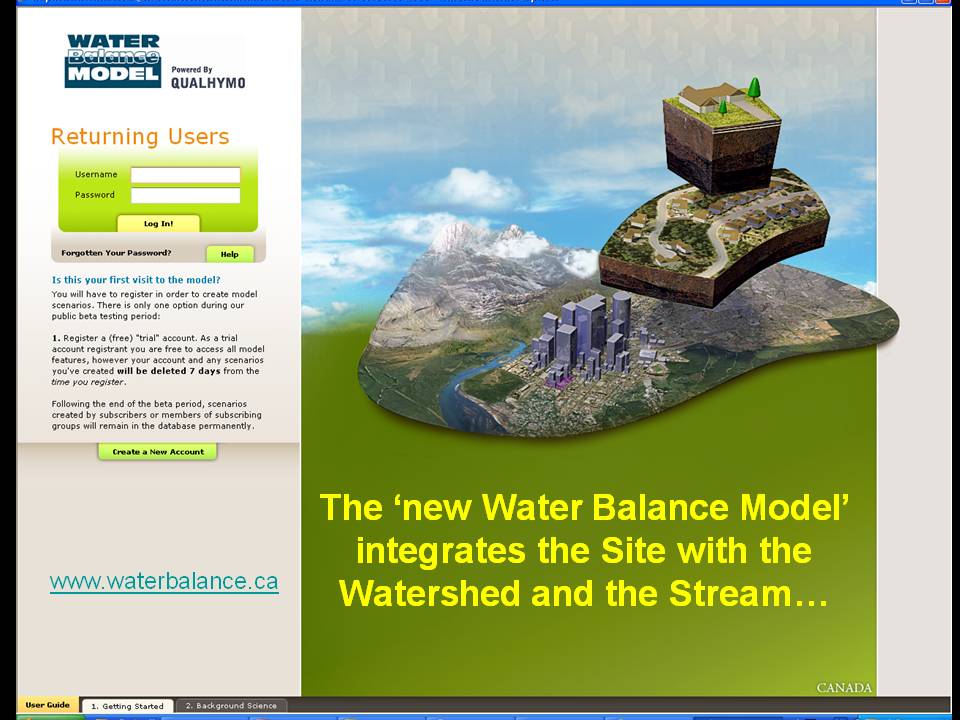FLASHBACK TO 2010: "Canada Mortgage & Housing Corporation is providing financial support for the Rainwater Harvesting Module to add to the capabilities of the Water Balance Model," stated Cate Soroczan, CMHC Senior Researcher
Note to Reader:
In November 2009, the British Columbia Inter-Governmental Partnership (BCIGP) and Alberta Low Impact Development Partnership (ALIDP) jointly released a blueprint document titled Water Balance Model for Canada – The Plan for the Future.
In February 2010, the partners announced that Canada Mortgage & Housing Corporation (CMHC) and City of Calgary had provided funding for development of the ‘Water Re-Use from Storage Module’ which was later re-named the Rainwater Harvesting Module.
Inter-Provincial Partnership announced development of Rainwater Harvesting Module
 “The Plan for the Future presents a road map for greatly increasing both the computational capabilities of the Water Balance Model and its usability in visioning future alternatives for use of water and land,” stated Ted van der Gulik, Chair of the Inter-Provincial Partnership (IPP).
“The Plan for the Future presents a road map for greatly increasing both the computational capabilities of the Water Balance Model and its usability in visioning future alternatives for use of water and land,” stated Ted van der Gulik, Chair of the Inter-Provincial Partnership (IPP).
“Several new modules will be added in 2010 – 2011, including the Water Re-Use from Storage (Rainwater Harvesting) Module. We are pleased to announce that the City of Calgary and the Canada Mortgage & Housing Corporation (CMHC) have provided funding for this module. This new capability will be functional by mid-2010.”
Funder Perspective: CMHC
According to Cate Soroczan, CMHC Senior Researcher, “The early success of the Water Balance Model in British Columbia generated interest in expanding the focus of the tool to reach a national audience. This culminated in the decision by CMHC in 2004 to fund development of the national portal at www.waterbalance.ca.”
 “Now, CMHC is providing financial support for the Water Re-Use from Storage Module because it includes a rainwater harvesting and storage component with variable sizing and demand. This capability will allow the user to optimize both the demand for potable water and the size of the physical storage required to achieve a maximum benefit. This adds to the capability of the Water Balance Model.”
“Now, CMHC is providing financial support for the Water Re-Use from Storage Module because it includes a rainwater harvesting and storage component with variable sizing and demand. This capability will allow the user to optimize both the demand for potable water and the size of the physical storage required to achieve a maximum benefit. This adds to the capability of the Water Balance Model.”
Funder Perspective: City of Calgary
“The addition of the Water Re-Use from Storage (Rainwater Harvesting) Module will increase the versatility of the Water Balance Model as a key tool in the City of Calgary’s toolbox of Low Impact Development strategies,” stated Liliana Bozic, of the City of Calgary. She is also ALIDP  Vice-Chair.
Vice-Chair.
“Primary goals of the City’s Stormwater Strategy encompass developing cost-effective and sustainable rainwater/stormwater solutions that will work with our climate and soils. Rainwater harvesting is an area of interest that we have been working on for a number of years. So the new module is timely.”
 “Indeed, our Development Approvals group sees an increasing number of applications for rainwater harvesting and stormwater re-use. This new module will therefore be greatly appreciated by Alberta WBM users,” added Bert van Duin, Senior Development Engineer with the City of Calgary. His responsibilities encompasse development approvals, infrastructure planning and water resources. Bert is also ALIDP Secretary.
“Indeed, our Development Approvals group sees an increasing number of applications for rainwater harvesting and stormwater re-use. This new module will therefore be greatly appreciated by Alberta WBM users,” added Bert van Duin, Senior Development Engineer with the City of Calgary. His responsibilities encompasse development approvals, infrastructure planning and water resources. Bert is also ALIDP Secretary.
Water Re-Use from Storage (Rainwater Harvesting) Module
 “Water re-use is an important next target for several reasons,” stated Jim Dumont, Engineering Applications Authority for the Inter-Provincial Partnership.
“Water re-use is an important next target for several reasons,” stated Jim Dumont, Engineering Applications Authority for the Inter-Provincial Partnership.
“On one hand, it is an integral part of a sound plan to manage water as a precious and limited resource. On the other hand, it plays a role in reducing runoff and consequent negative impacts from storm flows.”
“Taken together, this constitutes a solid area of practice to support and improve,” continued Dr. Charles Rowney, Scientific Authority for the Water Balance Model. “It is also an area which can be developed with confidence based on the existing WBM.”
 “To implement this capability the web site interface will require little adjustment, and the QUALHYMO engine already has a partial solution in place in the form of a cistern command that is a precursor to what is now needed. Further enhancement of this capability will address the needs of the users to evaluate the potential for reducing both the potable water demand and rainwater runoff in the urban environment.”
“To implement this capability the web site interface will require little adjustment, and the QUALHYMO engine already has a partial solution in place in the form of a cistern command that is a precursor to what is now needed. Further enhancement of this capability will address the needs of the users to evaluate the potential for reducing both the potable water demand and rainwater runoff in the urban environment.”
“The primary intent of the new module is to extend the QUALHYMO engine and WBM interface so as to enable assessment of domestic non-potable reuse of reusable rainwater as an alternative to discharge as waste,” summarized Jim Dumont.



